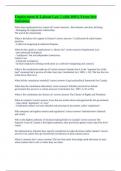Exam (elaborations)
Employment & Labour Law || with 100% Error-free Solutions.
- Course
- Institution
What does employment law consist of? correct answers - Recruitment, selection, & hiring. - Managing the employment relationship. The end of the relationship. What is the labour law regime in Ontario? correct answers - Certification & unfair labour practices. - Collective bargaining & indus...
[Show more]



